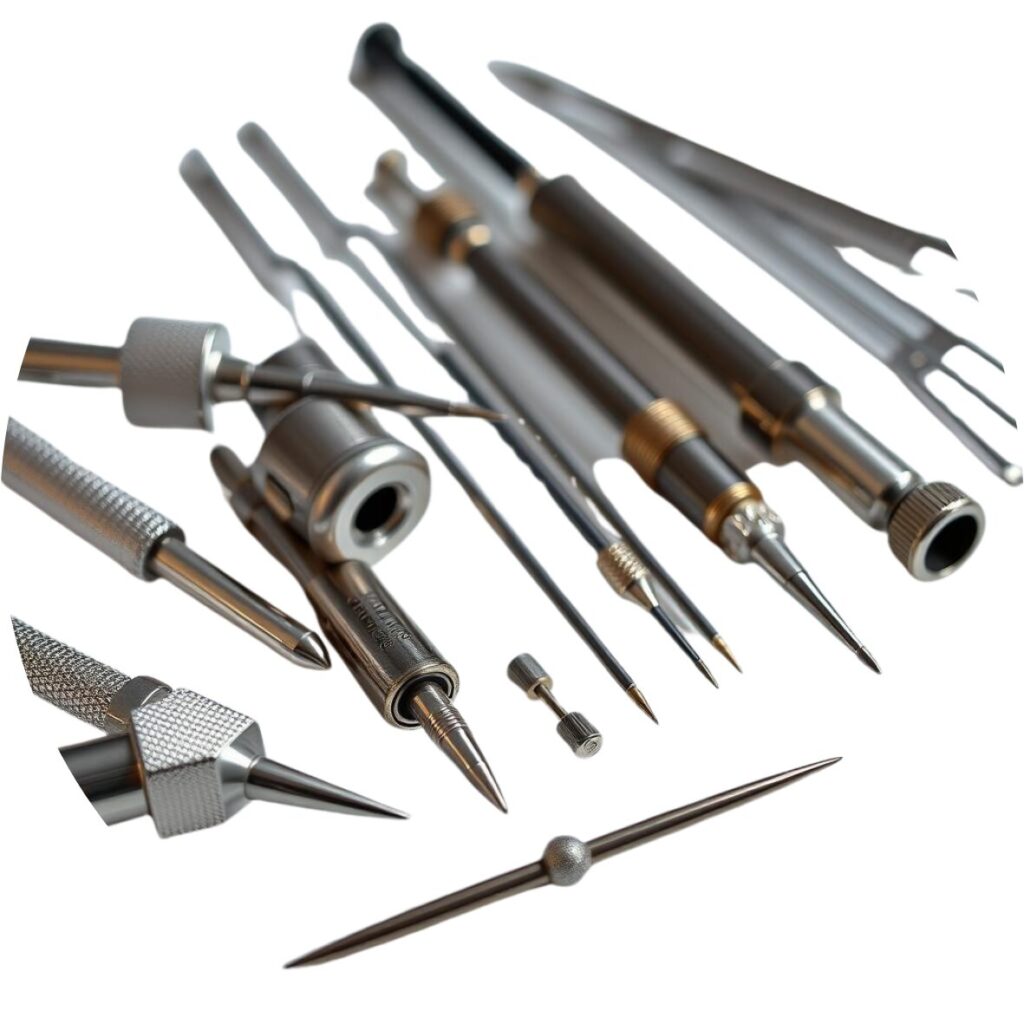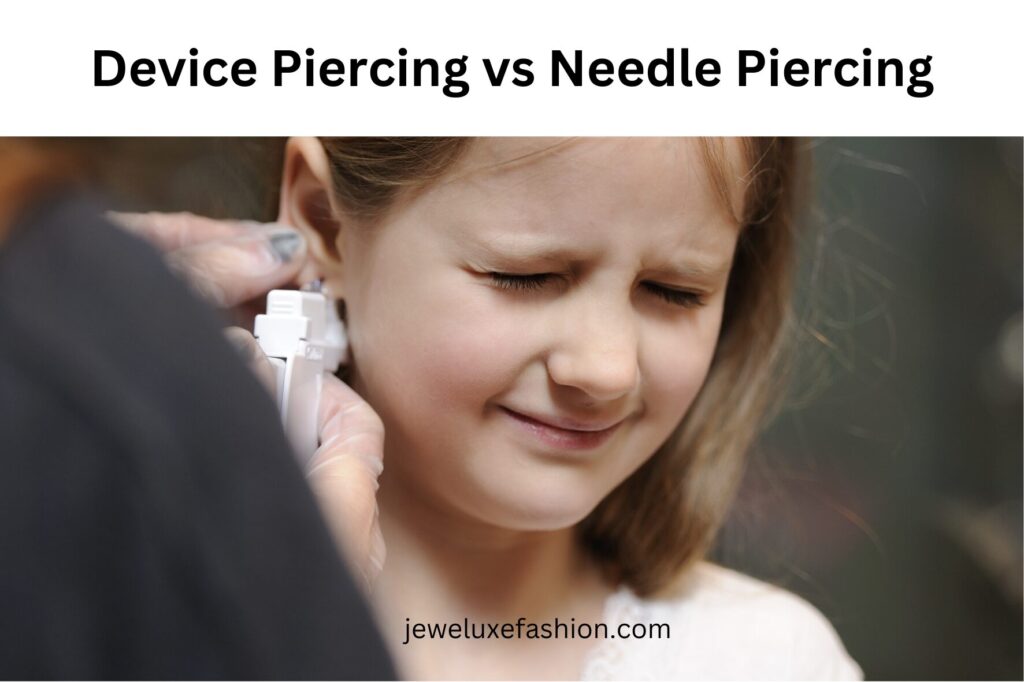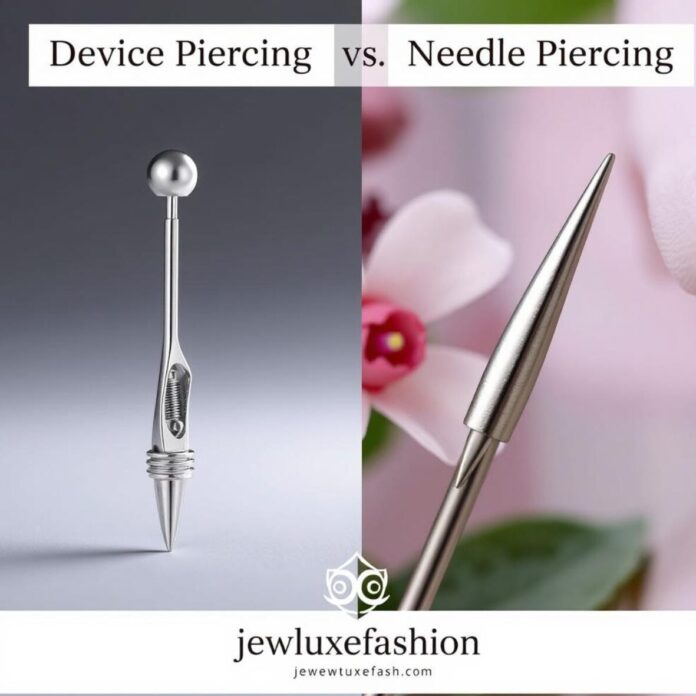Table of Contents
Introduction: Device Piercing vs Needle Piercing
Discover the key differences between device piercing and needle piercing. Explore the pros, cons, and how each method can impact your piercing experience and personal style. I love body art and self-expression. I often wonder: is device piercing better than needle piercing? Each method has its own good and bad sides. The choice can really change how you feel about your Piercing.
So, what makes these methods different? And which one is right for you?
Key Takeaways
- Device piercing and needle piercing are the two main ways to get pierced. Each has its own good and bad points.
- It’s important to know how these methods differ. This helps you make a smart choice for your next piercing.
- Things like safety, pain, healing time, and cost are key when picking between device and needle piercing.
- The body part you want pierced also matters. It can help decide which method is best.
- Clearing up myths about piercing can help you choose what’s best for you.
Understanding Device Piercing vs Needle Piercing: Basic Differences
There are two main methods for getting a body piercing: device piercing and needle piercing. Understanding the differences between them can help you make the best choice for yourself.
How Device Piercing Systems Work
Device piercing, or “needle-free piercing,” uses special tools to pierce your skin. It uses a spring to push a clean, single-use piece of jewelry through your skin. This makes it less painful and lowers the chance of getting sick.
The tools are made to work well and give the same results every time. This is why many people, especially first-timers, choose it for a smoother experience.
Traditional Needle Piercing Techniques
Needle piercing involves using a specialized needle to create an opening in your skin. A trained piercer carefully inserts the needle and then places the jewelry in the newly made hole. This method has been around for a long time but might feel more infectious to some.
Key Operational Differences
Device piercing and needle piercing differ in how they work and feel. Device piercing is faster and more controlled. Needle piercing lets you pick your jewelry and where it goes.
| Characteristic | Device Piercing | Needle Piercing |
| Piercing Mechanism | Spring-loaded device | Hollow, beveled needle |
| Procedural Control | Highly controlled and consistent | Greater flexibility and customization |
| Client Experience | Perceived as less invasive and more comfortable | May be perceived as more invasive and potentially more uncomfortable |
Safety Considerations for Both Piercing Methods
Safety is key when it comes to piercings. Both device and needle piercing have their own safety steps. These steps help make sure the piercing is done right and safely.
Sterilization Procedures
Professional piercers take many steps to keep things safe. They do this to avoid infections. Here are some of these steps:
- They sterilize all tools, including jewelry, in an autoclave machine. This kills off any bad germs or viruses.
- They sanitize the area where the piercing will take place both prior to and following the procedure.
- They also don gloves, masks, and other protective equipment to ensure a hygienic environment.
These careful steps are important for both device and needle piercing. They help make sure the piercing is safe and clean.
Potential Risks
Even with experienced piercers, there are some risks. These include:
- Allergic reactions to the jewelry material
- Infection from not being properly sterilized or not taking good care of the piercing
- Scarring or damage to the tissue from the piercing
It’s very important to pick a reputable and licensed piercing studio. This helps lower these risks.
Regulatory Standards
| Piercing Method | Regulatory Standards |
| Device Piercing | It is regulated by the FDA and must meet strict safety requirements. |
| Needle Piercing | It is regulated by state and local health departments, with varying requirements. |
Make sure the piercing studio you choose follows all safety rules and best practices. This is true for both piercing methods.
Pain Levels and Healing Time Comparison
Choosing between device piercing and needle piercing depends on pain and healing time. Knowing these can help you pick what’s best for you.
Pain Management During the Procedure
Device piercing hurts less than needle piercing. The special devices used in device piercing make a quick, less painful puncture. Needle piercing can feel more painful because of the pressure and pinching.
Expected Healing Periods
Healing times for device and needle piercings vary. Device piercings usually heal faster, in 4-6 weeks for ears and 6-8 weeks for other parts. Needle piercings take longer, 6-12 weeks to heal.
Aftercare Requirements
- Device piercings need simple care, like gentle cleaning and avoiding irritation.
- Needle piercings require more care, like regular cleaning and following piercer’s advice.
Choosing between device and needle piercing depends on your comfort and lifestyle. Knowing about pain, healing, and care helps you decide what’s best for you.
Professional Equipment and Sterilization Standards
When it comes to piercing, both methods need special tools and strict cleaning. As a pro piercing artist, I’m all about keeping things clean and safe. My studio is a place of high cleanliness and hygiene.
I use top-notch piercing tools and needles. These are from trusted makers. I also have durable piercing guns. All are cleaned and sterilized before use, following strict rules.
- Piercing needles come in single-use packs, sterilized by gamma-irradiation.
- Reusable tools get a deep clean, disinfect, and autoclave to kill germs.
- The piercing area is cleaned with strong disinfectants before and after each client.
The studio is set up for cleanliness and safety. It’s bright, has good air flow, and lots of handwashing stations. I follow strict rules for throwing away used needles and biohazards.
By using the best piercing instruments, sticking to sterilization standards, and keeping the piercing environment clean, I offer a safe and comfy piercing experience. This is true for both the device and needle methods.

Cost Analysis: Device vs Needle Piercing Services
Choosing between a studex 75 piercing device and traditional needle piercing is a big decision. The cost is a key factor to consider. Let’s look at the money side of these options to help you decide.
Initial Procedure Costs
Device piercing costs can start low. The studex 75 piercing device is a one-time buy for many piercings. Needle piercing, however, might cost more upfront because it needs a special piercer.
Long-term Maintenance Expenses
Device piercing might seem cheaper at first. But think about the ongoing costs. You’ll need to buy new parts and keep things clean. Needle piercing might be cheaper in the long run because the piercer takes care of the tools and cleanliness.
Insurance and Safety Certifications
Both methods must follow strict safety rules and get certifications. Getting and keeping these can cost money. Make sure your piercer follows all rules to keep you safe.
Think about the upfront costs, long-term expenses, and safety rules when deciding. Your choice should match your budget, preferences, and piercing needs.
Common Story and Misunderstanding About Both Methods
There are many stories and misunderstandings about device piercing and needle piercing. As a professional copywriting journalist, I’m here to clear up these stories. I want to give you accurate information to help you choose wisely.
Many think device piercing hurts more than needle piercing. But the pain can really vary. The experience can vary based on how much pain you feel, the expertise of the piercer, and the specific area being pierced. Both methods can feel the same, depending on the situation.
- Myth: Device piercing is always more painful than needle piercing.
- Fact: The level of pain can vary based on individual factors and the skill of the piercer.
Some believe device piercing is less clean than needle piercing. But, if you choose a reputable piercer, both methods can be safe and clean. It’s all about picking a skilled piercer who follows the rules, no matter the method.
- Myth: Device piercing is less hygienic than needle piercing.
- Fact: Proper sterilization and hygiene practices are essential for both methods.
Choosing between device piercing and needle piercing should be based on what you prefer. Think about the piercing spot and the piercer’s skill. By knowing the truth, you can make a choice that fits your needs.
Choosing the Right Method for Different Body Parts

Choosing between device and needle piercing depends on where you want to get pierced. Each method has its own good points and things to think about. It’s key to know the special things about different piercing spots.
Ear Piercing Considerations
Both device and needle piercing work well for ear piercings. But the ear’s shape and how thick it is can decide which one is better. Device piercing is good for thin earlobes because it’s gentler.
Needle piercing might be better for thicker ear parts. This is because it’s stronger and can handle thicker skin.
Other Body Locations
For other places like the nose, lips, or navel, needle piercing is often better. These spots need careful and precise work. This helps avoid problems and makes sure the piercing is in the right spot.
Anatomical Factors
Consulting with an experienced piercer is the most effective way to make your decision. They will assess the thickness of your skin, its elasticity, and the blood flow in the area. This helps pick the safest and most comfortable piercing method for you.
FAQ
What are the key differences between device piercing and needle piercing?
Device piercing uses a tool to quickly pierce the skin. Needle piercing uses a needle that is inserted manually. The main differences are in how they work and the experience they offer.
How do device piercing systems work?
Device piercing systems, like the Studex 75, have a spring-loaded mechanism. This mechanism pushes a pre-sterilized stud through the skin quickly. The stud is already in the device, ready to go.
What are the traditional needle piercing techniques?
Traditional needle piercing uses a sterile needle. First, the piercer marks the spot. Then, they insert the needle and put in jewelry right after.
What are the key safety considerations for both piercing methods?
Both methods need strict cleanliness and single-use equipment. Good piercing studios follow safety rules and use trained professionals. This ensures a clean and safe piercing.
How do the pain levels and healing times compare between device and needle piercing?
Pain can differ for everyone. Needle piercing is often seen as less painful. Device piercing can be sharper. Healing times also vary, with needle piercings healing faster.
What type of professional equipment is used in each piercing method?
Device piercing uses pre-sterilized studs and a special device. Needle piercing uses sterile needles inserted by hand.
How do the costs compare between device and needle piercing services?
Costs can vary. Needle piercing might be cheaper upfront. But both methods have similar long-term costs. The piercer’s experience and location also affect the price.
What are some common myths and misconceptions about device and needle piercing?
Some think device piercing is quicker and less painful. But this isn’t always true. Both methods need strict cleanliness to be safe.
How do I choose the right piercing method for different body parts?
The choice depends on the body part. Ear piercings often use devices. But other areas might need needle piercing. Skin thickness and anatomy also matter.


